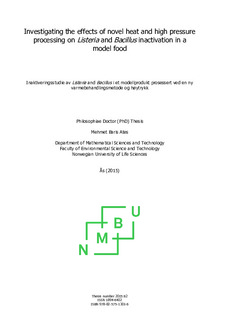Investigating the effects of novel heat and high pressure processing on Listeria and Bacillus inactivation in a model food
Doctoral thesis
Permanent lenke
http://hdl.handle.net/11250/2496756Utgivelsesdato
2018-05-02Metadata
Vis full innførselSamlinger
Sammendrag
Thermal processing is a common method for controlling foodborne pathogens in various ready-to-eat (RTE) products. Traditional processes that involve static heating often result
in undesirable quality changes in foods. These changes are due to slow heat penetration under conductive heating. Recent technologies such as agitating retorts or HPP can be an alternative for improving food quality through reduced processing time and overall heat load. Nevertheless, such novel technologies need to be thoroughly investigated with microbial inactivation studies to ensure that food safety requirements are met.
The overall aim of this PhD thesis was to investigate the effects of novel agitating retort and combined high pressure-temperature processing on elimination of Listeria and Bacillus in a model soup (pH 6.1). In this context, the effects of process parameters such as processing time, pressure and heating mode (agitated/static) on microbial survival were studied. Applicability of the classical thermal death model and response surface methodology (RSM) on agitating retort and combined high pressure-temperature processing was assessed, respectively. The same model soup (pH 6.1) was used for all experiments as the food substrate. Prosessering ved bruk av varmebehandling er en vanlig metode for å kontrollere og inaktivere patogene mikroorganismer i ulike ferdigretter. Tradisjonelle prosesser som involverer statisk varme resulterer ofte i uønskede kvalitetsendringer i mat. Disse endringene er forårsaket av lav varmegjennomgang under konduktiv varmeoverføring. Relativt nye teknologier som autoklavering med risting og høytrykksprosessering (HP) kan benyttes som alternativer for å forbedre matkvaliteten som følge av redusert prosesseringstid og samlet varmebelastning. Denne nyere type teknologier må bli nøye undersøkt med hensyn på mikrobiell inaktivering for å sikre at matsikkerhetskrav blir ivaretatt.
Hovedmålsettingen for denne PhD oppgaven har vært å undersøke effekten av autoklavering med risting og høytrykksprosessering med varme (HP-varme), og deres effekt på eliminering av Listeria og Bacillus i en modellsuppe (pH 6.1). Mikrobiell overlevelse ble studert ved å variere ulike parametere som: temperatur, prosesseringstid, trykk og risting eller statisk varme. Anvendelse av klassisk varmeinaktivering og RSM modeller for autoklaver med risting og HP-varme har blitt undersøkt. Den samme modellsuppen ble benyttet som modellprodukt i alle eksperimentene.
